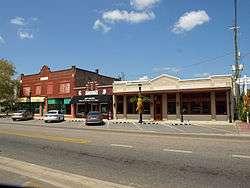Foley Downtown Historic District
The Foley Downtown Historic District, in Foley, Alabama, is a historic district which was listed on the National Register of Historic Places in 2005. The district was amended by a boundary decrease listing in 2012, and a boundary increase in 2019.[1]
Foley Downtown Historic District | |
 100s block of W. Laurel Ave, in 2012 | |
 | |
| Location | Parts of Alston, N & S McKenzie, AL 98, E & W Laurel, Myrtle, Rose, and W. Orange, Foley, Alabama |
|---|---|
| Coordinates | 30.406667°N 87.683889°W |
| Area | 230.6 acres (93.3 ha) |
| Architect | Frank Lockwood; Warren, Knight & Davis, et al. |
| Architectural style | Colonial Revival, Tudor Revival, et al. |
| NRHP reference No. | 04001496[1] (original) 100003122 (increase) 12000316 (decrease) |
| Significant dates | |
| Added to NRHP | January 19, 2005 |
| Boundary increase | September 20, 2019 |
| Boundary decrease | June 4, 2012 |
Boundaries originally encompassed parts of Alston, N. and S. McKenzie, U.S. Route 98, E. and W. Laurel, Myrtle, Rose, and W. Orange until a boundary decrease of June 4, 2012
The original listing included 29 contributing buildings and one contributing site on 230.6 acres (93.3 ha). It included:
- the Depot, i.e. the former railroad depot of Foley, which in 2003 was the City of Foley History Museum, at 125 East Laurel Avenue, (c. 1909; 1971; 1995). This is a one-story weatherboard Craftsman style depot building with a hipped and cross gable roof, decorative wood brackets, and a brick foundation. The building was moved Magnolia Springs in 1971 and was moved back to its original site in Foley in 1995.
- a Masonic Temple building (c.1925), designed in Mission Revival style by George B. Rogers of Mobile (see photo #25)[2]
Location: Parts of Alston, N & S McKenzie, AL 98, E & W Laurel, Myrtle, Rose, and W. Orange
Architects who have one or more works in the district include Frank Lockwood and Warren, Knight & Davis.
Architecture: Colonial Revival, Tudor Revival, et al. Historic function: Domestic; Commerce/trade; Government; Social; Religion; Industry/processing/extraction; Health Care Historic subfunction: Single Dwelling; Hotel; Specialty Store; Warehouse; Restaurant; City Hall; Meeting Hall Criteria: event, architecture/engineering
Foley Downtown Historic District (Boundary Decrease) Location: Parts of Alston, McKenzie, N. & S. Laurel & W. Orange Sts. Date added: June 4, 2012
It includes one or more works by architect Frank Lockwood.
Historic function: Government; Commerce/trade; Health Care; Recreation And Culture; Domestic; Landscape Historic subfunction: Post Office; Specialty Store; Hospital; Auditorium; Park; Single Dwelling; Business Criteria: event, event, architecture/engineering, architecture/engineering Number of acres: 19.4 Number of contributing buildings: 28 Number of contributing sites: 1
References
- "National Register Information System". National Register of Historic Places. National Park Service. November 2, 2013.
- Pamela Sterne King; Christy Anderson (October 12, 2003). "National Register of Historic Places Registration: Foley Downtown Historic District". National Park Service. Retrieved May 19, 2019. With accompanying 29 photos from 2003, including #25 of the Masonic Temple
- "National Register of Historic Places Inventory/Nomination: Foley Downtown Historic District (Boundary Decrease)". National Park Service. Retrieved May 19, 2019. With accompanying pictures
| Wikimedia Commons has media related to Foley Downtown Historic District. |